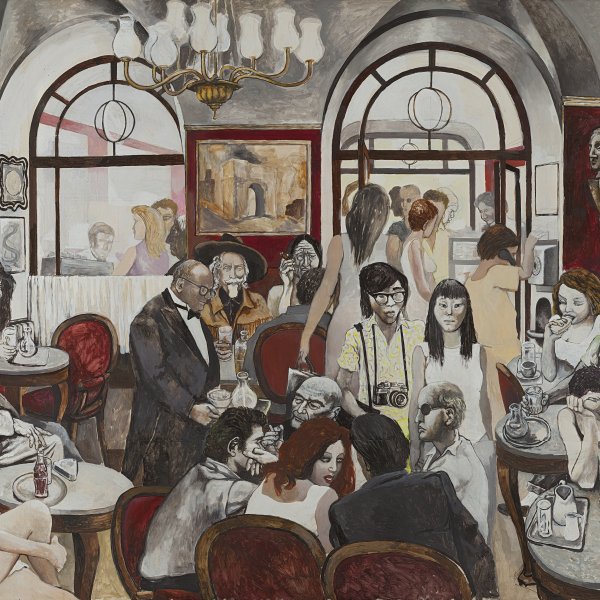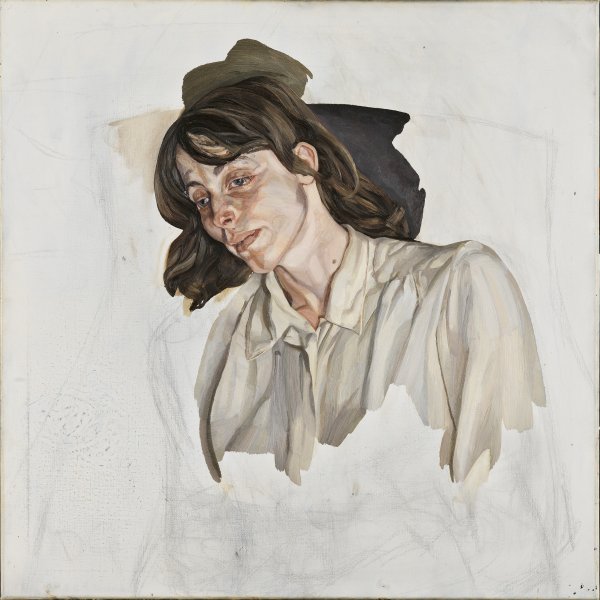Smyrna Greek (Nikos)
1976 - 1977
Oil on canvas.
243.8 x 76.2 cm
Museo Nacional Thyssen-Bornemisza, Madrid
Inv. no.
619
(1977.67
)
ROOM 52
Level 1
Permanent Collection
“I like the idea that it might be possible to invent a figure, a character, in a picture the way novelists have been able to do, ” Kitaj once confessed. The literary roots of his painting are particularly evident in Smyrna Greek (Nikos), not only because the figures are two poets, but because the scene tells a story. The artist gave a brief explanation of the present work in the catalogue of his exhibition at the Tate Gallery in London in 1994: “This portrait of my friend Nikos Stangos was inspired by his fellow Greek poet Cavafy, who described his daily walk past the brothels in the port of Alexandria. I had just returned to London from my only trip to Greece, which lasted very few days and while he posed for me in that walking position, I told Nikos about my bizarre and unconsummated wandering down the port of Piraeus, as if in imitation of C.P. Cavafy. So the painting is about the two poets and me.”
Like nearly all the people in Kitaj’s paintings, the main figure in the composition is painted from life. Located in the foreground, the London-based Greek poet and editor Nikos Stangos, who, as we have seen, is cast in the role of the homosexual poet Constantin Cavafy (whose work Stangos had translated into English, ) strolls indifferently past a prostitute positioned outside a brothel. Visible inside is a staircase which is descended by a person with an absentminded or satisfied look about him; Kitaj portrays himself, perhaps to show us that his painting is always based on a personal experience.
Marco Livingstone tells how Kitaj, who portrayed his own personal experiences with great truthfulness in his work, was somewhat astonished to discover that his private life was a source of inspiration for the main character in Sabbath’s Theater, the novel published by his great friend the American writer Philip Roth in 1996. It tells the story of a failed puppeteer whose youthful exploits in brothels are based literally on the accounts Kitaj had given Roth of his teenage sexual experiences. Where the main character, Sabbath, tells of his grief at the loss of his lover, Roth transcribed conversations he had had with Kitaj following the death of the artist’s own companion. Kitaj, an artist who wanted “to invent a character, a personality” in his painting just as “novelists were capable of doing, ” became himself the lead character in a novel about love and death, a novel in which the desperate pursuit of sex is none other than a manner of fending off the anguish of death.
Paloma Alarcó
Like nearly all the people in Kitaj’s paintings, the main figure in the composition is painted from life. Located in the foreground, the London-based Greek poet and editor Nikos Stangos, who, as we have seen, is cast in the role of the homosexual poet Constantin Cavafy (whose work Stangos had translated into English, ) strolls indifferently past a prostitute positioned outside a brothel. Visible inside is a staircase which is descended by a person with an absentminded or satisfied look about him; Kitaj portrays himself, perhaps to show us that his painting is always based on a personal experience.
Marco Livingstone tells how Kitaj, who portrayed his own personal experiences with great truthfulness in his work, was somewhat astonished to discover that his private life was a source of inspiration for the main character in Sabbath’s Theater, the novel published by his great friend the American writer Philip Roth in 1996. It tells the story of a failed puppeteer whose youthful exploits in brothels are based literally on the accounts Kitaj had given Roth of his teenage sexual experiences. Where the main character, Sabbath, tells of his grief at the loss of his lover, Roth transcribed conversations he had had with Kitaj following the death of the artist’s own companion. Kitaj, an artist who wanted “to invent a character, a personality” in his painting just as “novelists were capable of doing, ” became himself the lead character in a novel about love and death, a novel in which the desperate pursuit of sex is none other than a manner of fending off the anguish of death.
Paloma Alarcó











